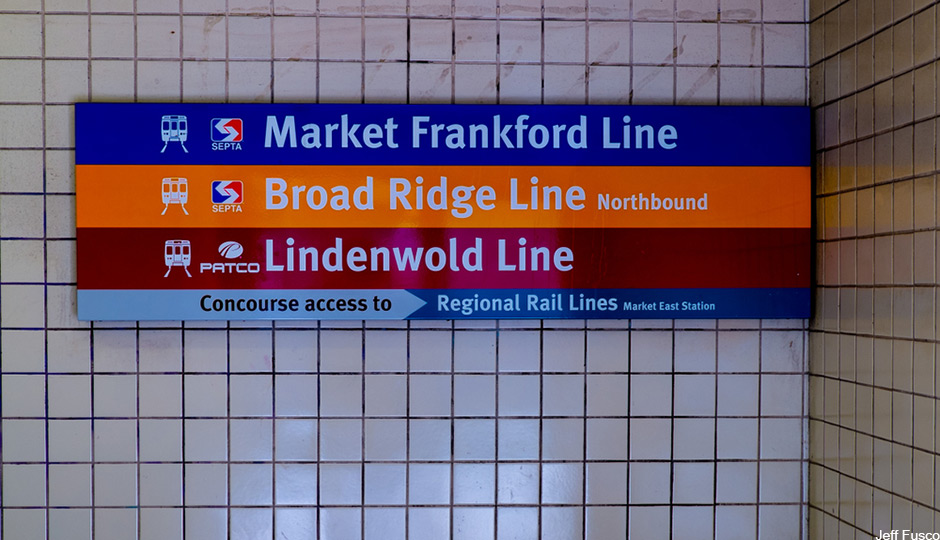Why the Rush to Revive 24-Hour SEPTA Subway Service?

Photo | Jeff Fusco
Lots of Philadelphians, particularly more recent arrivals, are excited about the prospect of the return of 24-hour rapid transit service. Restoring overnight service on the Broad Street and Market-Frankford lines, which SEPTA has announced it will do on weekends on a trial basis starting this summer, would return this city to a very select club of cities where one can catch a rapid transit train at any hour of the day. In North America, those cities currently number two: New York and Chicago.* Most other subways worldwide take the overnight hours off, though reports are that in Berlin, one can ride the U-Bahn all night on weekends as is being proposed here.
Although SEPTA spokesperson Jerria Williams recently told Metro that SEPTA has been considering this move for a while, there had been no inklings of this prior to the surfacing of an online petition urging the agency to make the change that garnered more than 25,000 signatures in a matter of about a month earlier this year.
I wonder how many of those signers actually live here, let alone ride SEPTA. Especially when a look through the agency’s own records shows that its own procedure for adding or modifying existing services produces no other evidence of any demand for this.
Last week, SEPTA wrapped up a series of public hearings on something called the Annual Service Plan. This document, the 17th edition of which is now in draft form (PDF), is SEPTA’s main tool for assessing system performance and the cost-effectiveness of changes in service.
The Annual Service Plan review process involves a nearly year-long series of proposals, reviews, assessments, announcements, and public meetings, all intended to make sure that riders and other community members have input into shaping the service SEPTA provides. Both agency staff and the general public may recommend adding, altering, or deleting routes. SEPTA then applies a formula, explained in the front of each Annual Service Plan, to determine the costs and benefits of each suggestion, then recommends adoption or non-adoption of changes based on several different criteria. The most common reason for rejecting a suggestion is “Insufficient Operational or Financial Resources.” Last year (PDF), for instance, 45 of 65 outside suggestions for new or changed service were rejected for at least this reason.
There is, however, a provision in SEPTA’s service planning policy that allows the agency to operate service on an experimental or pilot-project basis for up to one year before it must be subjected to Annual Service Plan evaluation. Williams explained that SEPTA is running overnight rapid transit service from late June through Labor Day, with a possible three-month extension if the results warrant it, under the terms of this provision.
Given the number of signatures on that petition, it may well be a good move on SEPTA’s part to start the 24-hour rapid transit experiment now. It does show a responsiveness to popular demand. But this experiment also falls into another category of suggestions that get rejected: “Duplicative Service.” Last year, SEPTA turned down 14 suggestions for new or altered routes, including a new route that would have provided a one-seat ride (meaning no transfers) down Roosevelt Boulevard into Center City, for that reason.
SEPTA also has service criteria that are intended to ensure that City of Philadelphia residents have access to round-the-clock transit service within a reasonable distance. But large chunks of the city, including almost all of the Northeast west of the Boulevard, Roxborough and Manayunk, have no overnight transit service of any kind.
Broad Street and Market-Frankford riders at least have round-the-clock service already. It’s just not a train. Instead, it’s a bus that operates in place of the trains from 12:30 a.m. to 5 a.m. Some have made arguments that this service is actually safer for riders because SEPTA policy also requires bus drivers to let off passengers wherever they wish to get off in the late night and overnight hours — even on the routes that are supposed to mimic rapid transit operations with limited stops.
Meanwhile, a number of service changes that the agency had in past years said were either worth implementing or warranted further study, including all-day express service on Route 14, the Roosevelt Boulevard spine line, and a new bus route that would provide service along Cheltenham Avenue between Olney and Cedarbrook Mall that was recommended in fiscal 2010 and 2011, remain unimplemented and unexamined.
Of course, both the Annual Service Plan and the pilot projects involve setting priorities. Some communities will see benefits while others may find their wishes ignored. And I, too, would rather take a train than a bus home from Center City when I’m out late. But at least I can still get home. Others living elsewhere in the city cannot. And there seems to me to be something a little unseemly about the speed with which SEPTA is making this a priority while other parts of the city are still waiting for services they want — and have even been promised.
Follow @MarketStEl on Twitter.
*Actually, if you want to be technical about it, metropolitan Philadelphia never left this club — but the only residents who enjoy 24/7 rapid transit are the South Jerseyites fortunate enough to live near PATCO stations.


